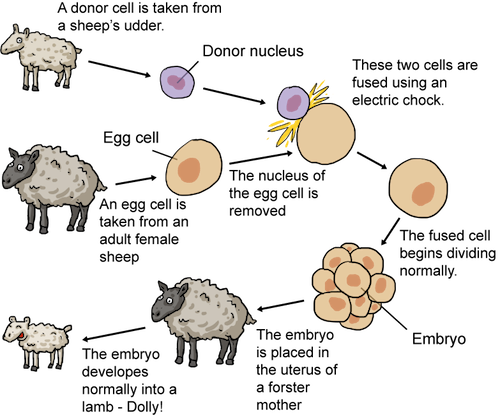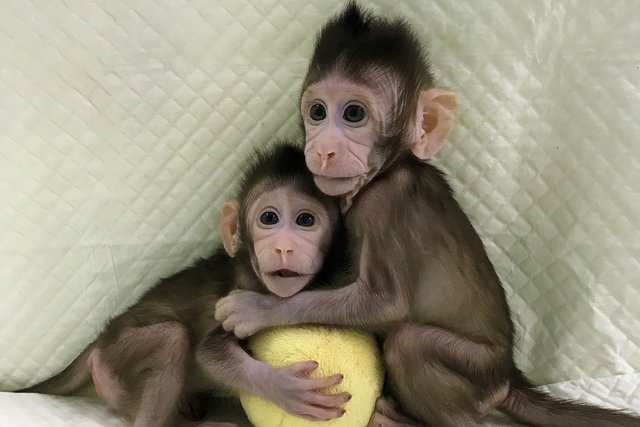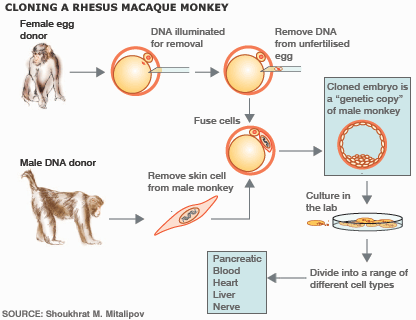Cloning, a stereotype applied by humans
Hello friends of steemit, this is my first publication in the area of science, and in this article I want to refer to cloning a process that has been criticized by some people, but in reality it is still applied. Sample of this is The cloning that exists in animals, in this article published talks about the latest cloning that humans have applied. I invite you to observe this
interesting publication!
Dolly the sheep was born as a result of an experiment conducted at the Roslin Institute, one of the most famous embryo manipulation centers in Edinburgh, the capital of Scotland.
On February 23, 1997, the news of the birth of the Dolly sheep, the first mammal cloned from an adult cell. For the first time, with a single cell of the udder of the sheep and an ovule that allowed to read the genetic information of that nucleus, Dolly was obtained, that had genetic characteristics identical to those of its mother.
This discovery occupied the covers of media of the whole world. He was actually born on July 5, 1996, but did not rise to fame until seven months later, on February 23, 1997, when researchers at the Roslin Institute in Edinburgh (Scotland), led by Ian Wilmut, presented it publicly and revealed that it was the result of a nuclear transfer from an adult donor cell to an unfertilized and nucleus-free ovule, which was then implanted into a carrier female.
Importance of the experiment:
The experiment that gave Dolly's life meant an important scientific advance for humanity, for its contribution to the fight to fight certain diseases, especially cancer and to improve the development of some drugs and facilitate the selection of lineages in livestock.
With cloning other research possibilities were also opened, such as copying transgenic animals, that is genetically modified, to create whole breeds with predefined characteristics, so that, for example, they were resistant to viruses.
Cloning of Dolly
From the udder of Dolly's mother, the scientists removed a cell, which contains all the genetic material (DNA) of the adult sheep. Then, to the other sheep, they extracted an ovule, which would serve as a receptor cell. The nucleus was removed from the ovule, thus eliminating the genetic material of the donor sheep. The nucleus of the mammary cell was extracted and, by means of electrical impulses, it was fused to the donor nucleus without a nucleus. With the same impulses, the ovule was activated to begin its division, just as the fertilized ovules do in a natural reproduction process. By the sixth day, an embryo has already formed, which was implanted in the uterus of a third sheep, the surrogate mother, who after a normal gestation period gave birth to Dolly: a sheep exactly like her genetic mother.
Death of the Dolly sheep
It was the most famous sheep in the world. But unfortunately at six years the scientists decided to sacrifice it because of the lung infection suffered, typical of adult animals of irreversible nature. The cloned sheep, born on July 5, 1996, left this world with only six years, quite less than the 12 that usually lives a sheep of his race. What is clear is that his health had deteriorated prematurely. In addition, he suffered from arthritis and an early aging procs.
From dolly cloning, years later, to be specific in the year that passes 2018, clone velve do something relevant.
But this time you experiment with primates (monkeys).
Wednesday that they have created two cloned monkeys, marking the first time that primates were cloned using the technique that produced the Dolly sheep more than twenty years ago.
The long-tailed macaques, called Zhong Zhong and Hua Hua, were made from fetal cells grown in a petri dish. The clones are identical twins and carry the DNA of the monkey fetus that originally contributed the cells, according to a study published in Cell. The clones were born at the Chinese Academy of Sciences in Shanghai.
The Dolly sheep was created from udder cells that had been frozen for six years. Before this advance, many researchers thought that this type of cloning was impossible, because it required taking adult cells and returning them to their original state, when the sperm fertilized the egg.
Then, the cell would have to have started growing in a surrogate belly to form an entire animal, genetically identical to the one that the initial cell provided.
However, when it was proved that cloning was possible, researchers began to improve their method and to test it in other species. Since Dolly was born, researchers have cloned twenty-three species of mammals, including cattle, cats, deer, dogs, horses, mules, oxen, rabbits and rats.
However, the new cloned monkeys stand out. "They are the first primates to be cloned," said Leonard Zon, director of the Stem Cell Program at Children's Hospital Boston. "We are closer to cloning humans than we have ever been."
Four of these substitutes remained pregnant, but two had spontaneous abortions. In the end there were two successful births.
The researchers state that they followed international guidelines for animal research presented by the National Institutes of Health. They anticipate that the method could be used to create monkeys for research (although the United States has withdrawn from the use of primates in medical research).
If scientists had wanted to create a monkey identical to an adult, or even an adolescent, this method would not be successful. And the technique used by Chinese scientists is still far from producing human babies, even if it were ethically permissible.



 [
[